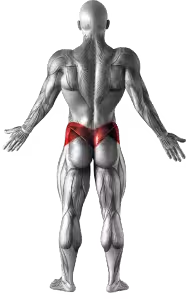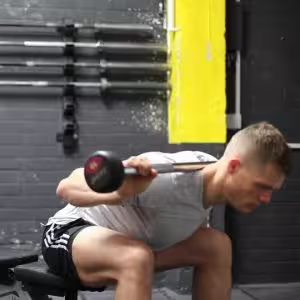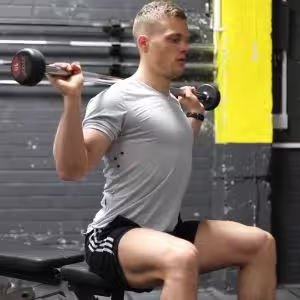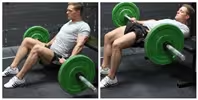The Seated Good Morning is an effective lower back and hamstring exercise that strengthens the posterior chain. By sitting on a bench with a barbell across your upper back, you isolate the muscles of the lower back, glutes, and hamstrings. The movement helps improve flexibility and strength in the hamstrings and lower back, making it an excellent choice for anyone looking to build strength and improve posture.
Seated Good Morning Video
How to Perform Seated Good Mornings
Seated Good Morning Images
Step-by-Step Instructions:
- Set Up the Bench: Sit on a bench with your feet flat on the floor. Place a barbell across your upper back (not your neck) with a comfortable grip.
- Choose the Right Weight: Select a weight that you can manage with proper form. Start light to avoid overloading your lower back.
- Brace Your Core: Engage your core muscles and keep your chest up, maintaining a neutral spine throughout the movement.
- Begin the Movement: Hinge forward from your hips, lowering your torso towards the floor while keeping your back straight.
- Return to Starting Position: Reverse the movement, pushing through your glutes and hamstrings to return to the starting position.
- Complete the Reps: Perform the movement for your desired number of reps, ensuring you maintain control and proper form throughout.
Seated Good Morning Benefits
- Strengthens Posterior Chain: The Seated Good Morning targets the hamstrings, glutes, and lower back, strengthening the entire posterior chain.
- Improved Flexibility: Regularly performing this exercise can increase flexibility in the hamstrings and lower back.
- Better Posture: Strengthening the lower back and core improves overall posture and helps reduce lower back pain.
- Enhanced Stability: This exercise builds stability and control in the hips and lower back, supporting other compound lifts.
- Reduced Injury Risk: Strengthening the posterior chain helps to reduce the risk of injuries, especially in the lower back.
Seated Good Morning Muscles Worked
Targeted Muscles
The Seated Good Morning primarily targets the hamstrings, glutes, and lower back (erector spinae). Secondary muscles involved include the core and hip flexors, which help stabilize the movement throughout the exercise.




